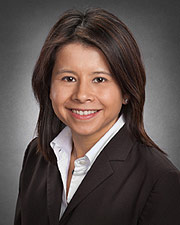TLR4 Signaling in the Pathophysiology of Allergic Fungal Rhinosinusitis
Over the last several decades, the model of a unified airway linking the upper and lower airways into one functional unit has emerged to help explain overlapping epidemiologic data between chronic rhinosinusitis and asthma. According to the model, an inflammatory disease that affects one site will increase the risk of developing a similar inflammatory change throughout the airway.

Amber Luong, MD, PhD
“The prevalence of asthma in CRS patients is reported at approximately 20 percent, much higher than the 5 to 8 percent prevalence in the general population,” states Amber U. Luong, MD, PhD, who is an assistant professor and director of research in the Department of Otolaryngology-Head and Neck Surgery at UTHealth Medical School. “Recent epidemiologic data suggest that asthma is even more prevalent – at about 50 to 60 percent – in patients with CRS with nasal polyps (CRSwNP). Although allergic fungal rhinosinusitis (AFRS) represents a clinical subtype of CRSwNP, passive surveillance studies suggest a significantly lower prevalence of asthma in AFRS patients as compared to other CRSwNP patients. However, there are no formal prospective studies in which asthma has been objectively confirmed to report the true prevalence of asthma in these two patient groups. Discerning this difference, if it truly exists, would support the idea that AFRS is in fact a unique entity from other CRSwNP.”
With a recently awarded $44,000 grant from the American Academy of Otolaryngic Allergy (AAOA) Foundation, Dr. Luong, who also has an joint appointment in the Center of Immunology and Autoimmune Diseases at the Brown Foundation Institute of Molecular Medicine for the Prevention of Human Diseases, will conduct an epidemiologic study determining and comparing the prevalence of asthma in AFRS as compared to non-AFRS CRSwNP patients by investigating the role macrophages and sinonasal epithelial cells play in fungal containment and development of lower-airway inflammation. The study will also investigate an innovative signaling pathway activated by fungal proteinase that may differentiate AFRS from non-AFRS CRSwNP patients.
“The study will build on observations from a clinical database collected on more than 200 patients who underwent sinus surgery over two years,” she says. “CRS is a phenotypically heterogenous disorder that remains poorly categorized. By undertaking a prospective study in which the diagnosis of asthma is based on history and diagnostic pulmonary function testing consistent with a hyper-reactive lower airway, we hope to establish more precise definitions and identify novel therapeutic drug targets.”